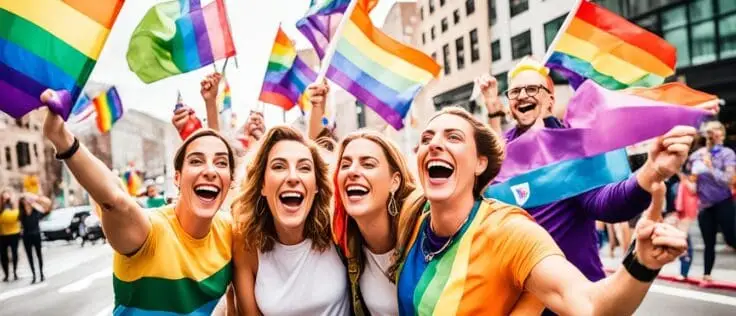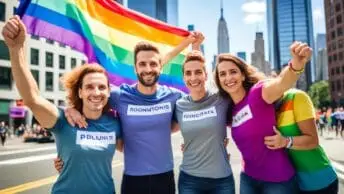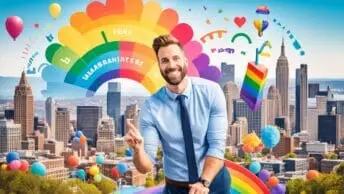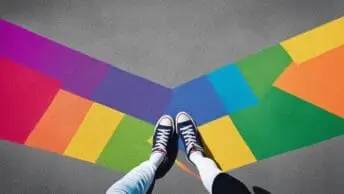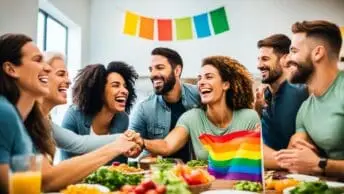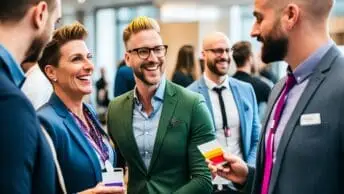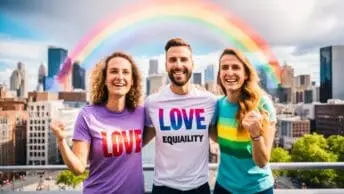How can inclusive stories in media and adverts change society’s view? How can they affirm identities of often overlooked communities?
Elijah Cruz talks about the big impact media representation has on what people think. He believes it helps accept groups that were ignored in the past, like the LGBTQ+ community. In the UK, showing LGBTQ+ people positively isn’t just about being inclusive. It’s about celebrating the variety and depth in our society.
The way characters are shown in media can break down stereotypes. It gives people a sense of belonging. It also helps equality in adverts.
Kids between 3-17 watch up to 46.1 hours of TV every week, Ofcom found in 2019. This shows how important good representation is. It shapes what they think and gives them heroes to look up to. Since 2005, GLAAD reports have highlighted the need for real LGBTQ+ stories on TV. Dr. Ranj supports this with initiatives like the Secret Santa campaign.
In times where being inclusive is more celebrated, showing LGBTQ+ people correctly is crucial. It’s about challenging old stereotypes and promoting acceptance through ads. Our aim is to boost positive LGBTQ+ visibility. This will help build a society that welcomes everyone.
The Role of Media in Shaping Public Perception
The UK’s Ofcom highlights the media’s role in influencing what people think and accept as normal. Media outlets decide what behaviours and lifestyles get seen as ‘normal’. This greatly affects what the public believes. Media can promote inclusiveness or spread negative stereotypes.
Research shows that 83% of LGBTQ+ folks think positive media stories help lessen stigma. Media shapes what people think, with 57% of LGBTQ+ youth feeling better about themselves after seeing positive media images. When 45% of LGBTQ+ people feel more accepted because of positive media, it’s clear its influence is huge in shaping society.
People also back media pushing for diversity, with 68% wanting brands to show more diversity in ads. Many LGBTQ+ people, 76% to be exact, say media and ads can change how society views LGBTQ+ issues. Moreover, 82% of folks trust brands more if they are open and inclusive in their marketing.
Media companies have a powerful spot in affecting how we see the world and each other. Their work influences public opinions and norms. So, the impact of media in either promoting diversity or practicing good journalism cannot be ignored.
The Impact on Children and Young People
Children’s media deeply influences young minds, shaping their growth and how they see themselves. Statistics Canada found kids spend about 2 hours each day watching TV. This shows how crucial media is in helping them develop positively.
Even babies start watching TV early, Certain LK and Kahn RS found. With UK kids sometimes watching up to 46.1 hours a week, reported by Ofcom, the stories they see are important. They can help kids feel good about who they are.
TV can affect kids’ self-esteem, studies say. If what they watch doesn’t show diverse characters, some kids may feel left out. For instance, 65% of characters in North American kids’ TV are white.
Seeing people like themselves on TV can make kids feel better, says the American Academy of Pediatrics. Music videos that include everyone can also boost how young people feel about themselves. But, even though more diverse characters are in children’s books now, not many are written by Black, Latinx, or Native authors.
In Sweden, media campaigns helped reduce alcohol problems among the youth, says Romelsjo A. This shows media’s power to make a difference in kids’ lives. By sharing diverse and positive stories, media can help all children feel valued and proud.
LGBTQ+ Representation on Television
The yearly analysis by GLAAD, ongoing since 2005, has steadily highlighted the trends in LGBTQ+ TV representation. This ongoing examination is crucial. It fosters empathy and validation among young LGBTQ+ viewers. Yet, the representation’s quality often varies, with some characters leaning into stereotypes.
Shows like “Heartstopper” have been praised for their wholesome romantic stories about LGBTQ+ characters. They offer a sense of acceptance and normalcy. “Schitt’s Creek” also received attention for its portrayal of positive relationships. It notably presents David’s pansexuality and his partnership with Patrick.
“The Owl House” breaks new ground with a bisexual protagonist, Luz, and a non-binary character, Raine. These portrayals positively reflect the LGBTQ+ community’s diversity on television.
Such representation helps LGBTQ+ youth feel seen and valid. It encourages a society that accepts diverse identities. Though there’s room for improvement, these examples pave a hopeful path for media’s future.
Media Representation
Media representation is key in shaping how we see LGBTQ+ identities in the UK. The growth of diversity in media has led to more inclusive stories. These stories go beyond old traditions. Media, by editing and choosing content, shapes how we see gender and social issues.
The process of making media involves creating a version of reality. This can change how people think, for better or worse. Books like “Julian is a Mermaid” and “The Black Flamingo” have helped. They tell stories that celebrate many identities, moving past old views.
Stuart Hall talked about the influence of media. He said those who make media can shape what we think is normal. Positive stories about LGBTQ+ people in media help make diversity more normal. They share different lives and experiences with everyone.
How media shows stories matters a lot in the UK. The choice of words and what’s included or left out affects what we think. Media doesn’t just show us the world; it helps make meaning of it. Looking at how studies challenge this idea is important to understand its big impact.
The move towards telling diverse and inclusive stories in UK media is changing things. As media becomes more diverse, we get to see more true to life stories of LGBTQ+ people. This is good for everyone.
How Advertising Reflects LGBTQ+ Inclusivity
Ads are key in promoting inclusivity and positive LGBTQ+ messages. Recent surveys show that 86% of people think LGBTQ+ representation in ads shows a company’s LGBTQ+ rights support. This viewpoint helps businesses connect with more people and highlight their dedication to diversity.
Inclusive ads also boost public acceptance. Nielsen states that ads focusing on sexual orientation and gender identity resonate with LGBTQ+ audiences. This means more people in the UK are open to supporting brands that include LGBTQ+ inclusivity.
The numbers speak clearly: 48% feel more accepting of gay and lesbian individuals after seeing LGBTQ+ representation in the media, compared to just 35% who hadn’t. Also, 80% of those who saw LGBTQ+ media feel a stronger support for equal rights, unlike the 70% who hadn’t. Inclusive ads, therefore, not only mirror a brand’s values but also help create a more accepting society.
Advertisers that feature LGBTQ+ individuals are praised for valuing diverse perspectives. A striking 82% of people think this shows a commitment to diversity. Also, 85% believe it shows a company’s dedication to cater to everyone, boosting its image and market presence.
To conclude, putting LGBTQ+ messages in advertising goes beyond marketing. It’s a significant push for social inclusivity. Brands that adopt this method show their modern values and help build a more inclusive, accepting world.
Recent Trends and Challenges in LGBTQ+ Media
LGBTQ+ representation in media has improved recently. This has led to more diverse stories that increase inclusivity. Yet, there are still big challenges. These include shows being cancelled early and not enough queer content in general. This makes it hard for LGBTQ+ characters to be seen widely.

Streaming services are now the main places where we find LGBTQ+ content. But, they still don’t have enough variety in their shows and films. This means there’s a big need for more consistent and varied LGBTQ+ stories.
Another problem is the mental health of LGBTQ+ individuals. The lack of representation can make them feel isolated and increase internalised homophobia. This shows the urgent need for media to include more LGBTQ+ stories.
There’s a push to make queer relationships more common in popular culture. This helps create a more accepting society. Yet, it’s important that these characters are deep and real, not just tokens. We need stories that challenge stereotypes and add to our cultural discussions.
Understanding theories by Stuart Hall and Roland Barthes helps media creators. It shows them how their portrayal of LGBTQ+ figures affects viewers. It’s crucial that media shows authentic and varied LGBTQ+ experiences. This is key to advancing LGBTQ+ visibility and acceptance.
The Role of Streaming Platforms
Streaming sites like Netflix and Amazon have changed the way we watch TV and films. They made DVDs less popular. People now enjoy being able to choose what and when they watch with ease.
Big names in streaming have been making their own shows and movies. This draws in people who want new and different stories. They offer something for everyone, which keeps subscribers coming back for more.
These platforms have shaken up the traditional TV world. They let viewers from all over the world watch their content. But, as more streaming services pop up, some worry we might get tired of subscribing to many of them. There’s also talk about whether a few big companies control too much of what we watch.
Streaming services are doing a great job at showing more diverse stories, including those of the LGBTQ+ community. In 2019, most popular shows had a good mix of characters from different backgrounds. This has made it an important space for stories about the LGBTQ+ community.
These platforms have also been a boon for independent filmmakers. They can now reach a global audience with their work. It’s important, though, to keep pushing for even more diversity in what gets shown.
It’s crucial to support diversity in streaming and LGBTQ+ stories. They help make our media more inclusive. By continuing these efforts, streaming services can ensure that everyone sees themselves represented on screen.
The Societal Benefits of Positive Representation
Studies show media representation has many benefits. It helps both the depicted communities and society. The Pew Research Center found US views on same-sex marriage changed greatly from 2004 to 2019. In 2004, 60% were against it, but by 2019, 61% supported it. This shift is linked to positive LGBTQ media depictions, which show diversity’s impact on acceptance.
Media diversity does more than just change opinions. The Intergroup Contact Theory says positive LGBTQ media can lessen stereotypes and prejudice. This makes society more welcoming. Social media also helps LGBTQ youth find support, especially important during the COVID-19 pandemic when many struggled with mental health.
Not showing diverse groups in media harms not just those groups but everyone. Studies show a lack of representation can damage self-esteem and identity, notably among Asian Americans and people of colour. Creators like Mindy Kaling show the power of real, diverse stories. They make those underrepresented feel seen, helping society as a whole.
Ignoring diversity in media leads to negative effects such as bias and discrimination. Tokenism and typecasting restrict the growth of minorities in the industry. Long-term TV viewing has been shown to lower self-esteem in girls and Black boys. It can make racial and gender biases worse.
Today’s youth want more diversity in media, covering Black, Asian, Brown, LGBTQ+, and disabled groups. It’s important to understand representation’s wider benefits. Media that reflects society’s diversity is key. It helps promote acceptance and build a more inclusive world.
Case Studies of Positive Representation in Media
‘Heartstopper’ is a key example of how LGBTQ+ stories can be told well. Created from Alice Oseman’s graphic novels, it’s praised for showing real LGBTQ+ teen relationships. It shows young LGBTQ+ people characters they can understand, filling a big need for better representation on TV.
‘Schitt’s Creek’ is also celebrated for its LGBTQ+ characters. Eugene and Dan Levy created the show with authentic, stereotype-free gay characters. It’s special because it shows these characters in good, healthy relationships. This is a big change from the negative portrayals often seen in the past.

‘The Owl House’ is notable for its diverse characters. Created by Dana Terrace, it features a bisexual main character. It shows why it’s important to have varied sexual orientations in kids’ TV. Despite some challenges, it points out the importance of representation. It helps kids find shows that reflect their lives, often turning to YouTube and TikTok for this.
In the UK, while only 15% of top news editors are non-white, there’s been more ethnic diversity in media recently. Still, advertising often shows lighter-skinned individuals, especially in campaigns for women and girls. Shows like ‘Heartstopper’, ‘Schitt’s Creek’, and ‘The Owl House’ lead the way. They offer more diverse and inclusive stories, helping to create a richer media environment for all.
Conclusion
In recent years, the UK has made great strides in acceptance and diversity in media and ads. However, 41% of LGBTQ+ people still feel they’re not shown correctly in ads. This shows we need to do more for true inclusivity. On a brighter note, LGBTQ+ visibility in TV ads has gone up by 31% in five years. This shows a move towards better and more positive representation.
When brands include LGBTQ+ people, they see real benefits. Kantar’s research says that having LGBTQ+ people in media makes people like and trust these brands more, boosting their ratings by 39%. Also, such ads make LGBTQ+ customers 23% more loyal to a brand. YouGov found that 68% of LGBTQ+ consumers prefer brands with LGBTQ+ friendly ads. This shows the power of diverse and complex representation.
Positive LGBTQ+ images do more than just help brands. They create a culture of acceptance and inclusivity. Media and ads can deeply change how we see the world, making us more empathetic and understanding. So, media companies, content creators, and advertisers have a big job. They need to show the LGBTQ+ community in a true and inclusive way. By doing this, we can hope for a media that shows the diversity of British society. This makes sure all voices are heard and valued.
